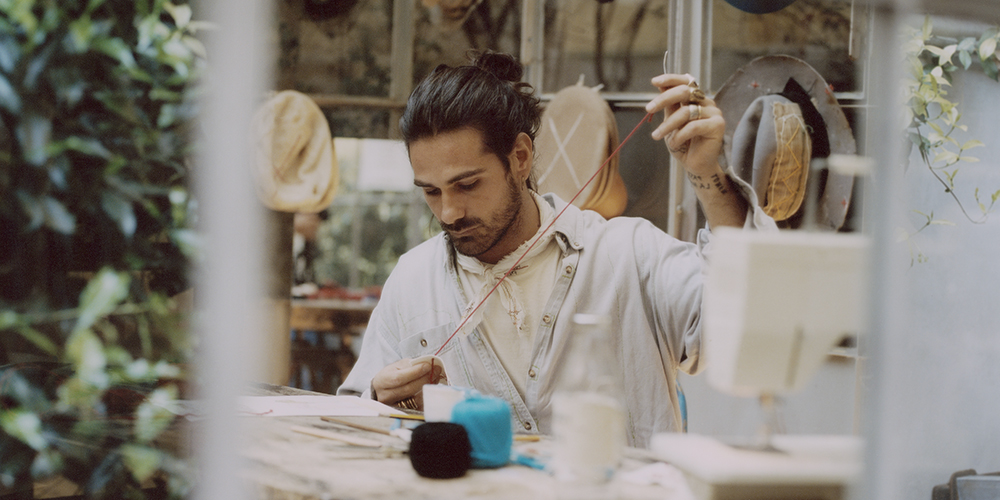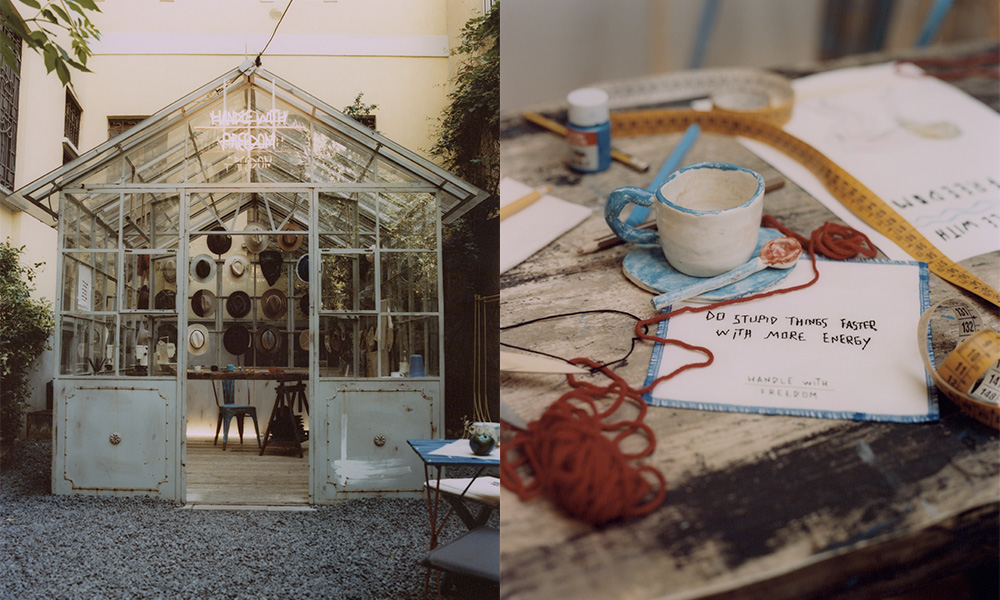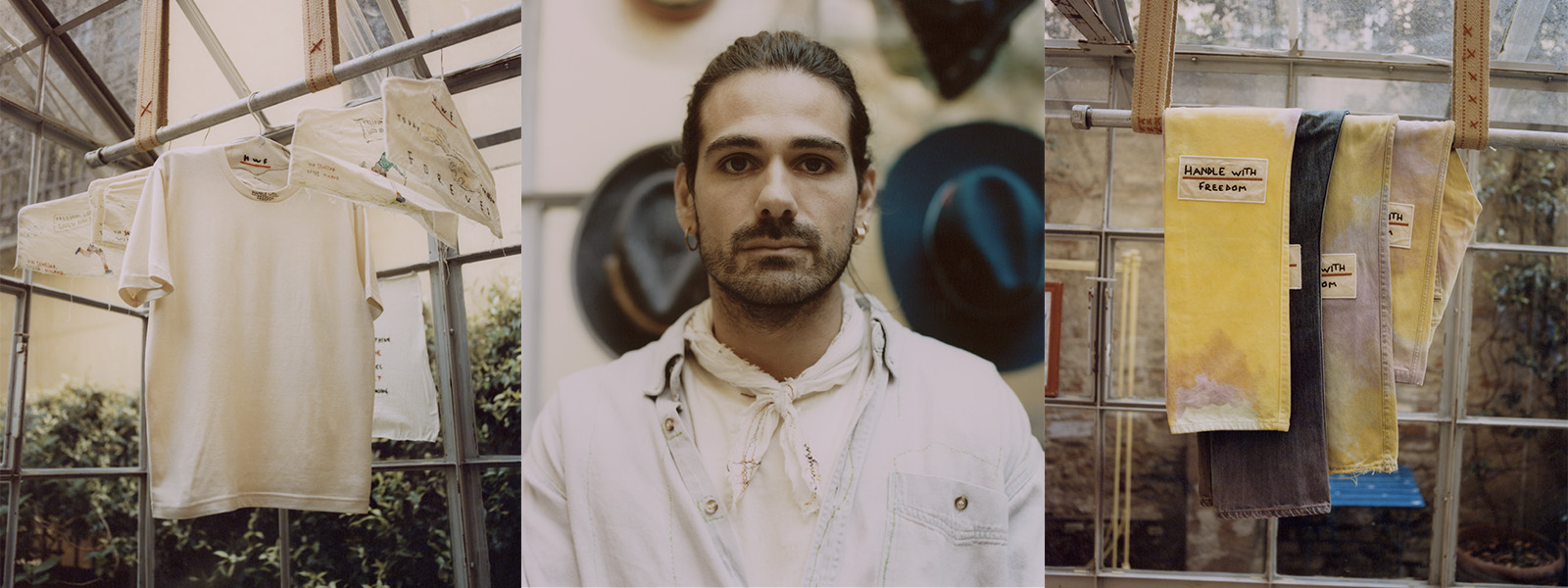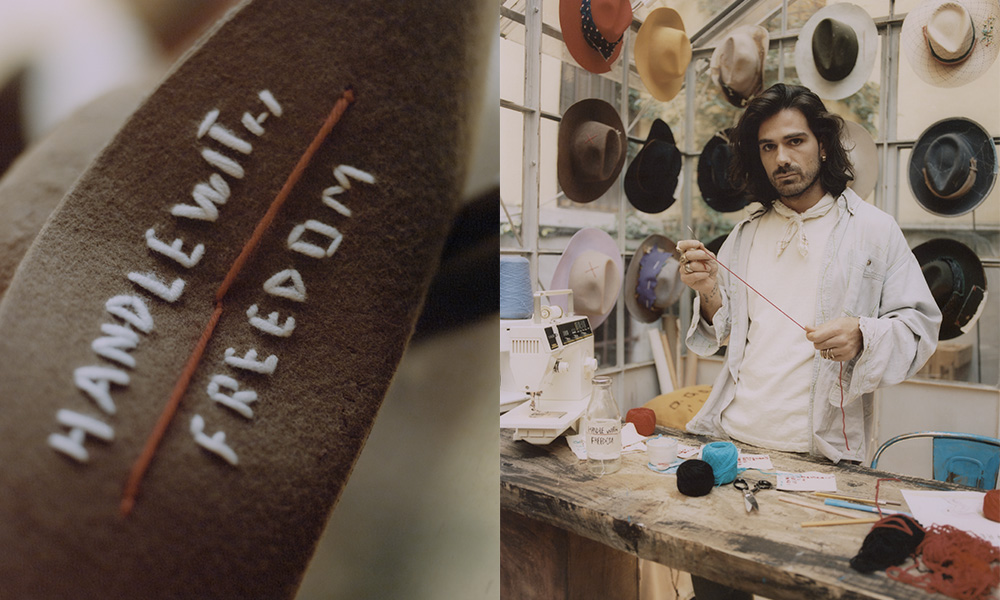
SUSTAINABLE SYMPOSIUM
Handle With Freedom
by Omar Riccardo Krichi
Giotto Calendoli doesn’t like the word ‘designer’, or rather, he doesn’t like labels. Neapolitan at heart, Milanese citizen and perpetually wandering soul, he’s established his brand’s headquarters in a little house made of metal and transparent panels inside a noble courtyard of a palace in the centre of Milan. Halfway between a greenhouse, a hut and refuge à la Into The Wild, Handle With Freedom’s office does not enclose itself within four walls, but seeks to escape the physical confines of its perimeter to remain always with a glance towards the outside, whether it be a green spot full of garden gnomes, or a remote village in Mexico. Between hats, coffee mugs and hand-sewn placemats, Giotto tells us about his ethical, serene, but above all free vision of life and of creating garments.
Giotto, your aesthetic is highly recognisable, as is the cultural identity of your hometown, Naples. Do you think this personal background has significantly influenced the character and philosophy of your brand?
Naples is a great source of inspiration for me that I try to take with me with great pride, especially when I travel. When I was 18 I left home, and it was like running away from a city that oppressed me, but today my relationship with Naples is mature, and it gives me lot of inspiration and energy. For example, I’m now making a collection that’s based entirely on helping ten women from the Pozzuoli women’s prison.
‘HANDLE WITH FREEDOM’ is the name/statement you’ve chosen for your brand. It sounds like a suggestion, but perhaps also a warning. What meaning do you give to this motto?
When I was younger, my grandmother would open her wardrobe and give me incredible things from my grandfather, from accessories to crazy clothes and shirts. Every time, she’d tell me: ‘Take care of it, and treat it well’. The concept I was referring to was basically this. Besides taking good care of it, one has to understand that yes, every garment has its own background in life but it also needs freedom, to come out of its past and evolve. In this sense, HWF also wants to incorporate a message that invites people to express themselves freely and outside of conventions.
What needs, or impulses, led you to found your brand? Do you have a specific memory you can refer to?
It all started 10 years ago, when I moved to Milan with my ex-girlfriend. The social revolution hadn’t happened yet, and people
were mostly expressing themselves through blogs. In Milan we met the guys from NSS Factory, who were interested in the blog we were editing. So, they started taking us to events and introducing us to the Milanese fashion system. It was when I started having collaborations with brands and wearing their clothes that I felt the need to find something that really represented my mood, personality and body. Finally, I went so far as to think that one day I could design my own collection.

HWF is characterised by its unisex cut, soft colours and reminiscences of a nomadic, bucolic carefreeness. How would you sum this up?
The mood of a person who wants to live his life in well-being, and by well- being I mean simplicity. A run in the meadows, perhaps even naked, or on a plane taken at the last minute to leave for unknown destinations, or the carefreeness of putting into practice all the experiences that so many cultures can give you. It’s there that all colours blend into one.
It’s common to think that emerging brands must somehow find a distinctive and international factor to stand out from the others. Do you think that the ethical awareness of a sustainable approach can also make a difference in terms of visibility?
It has to make a difference, whether its visible or not. Today, with all the things we produce and consume, we have to think ethically. To have this resonance we must start from a background of ethical awareness. It’s obviously easy to talk about it without taking action (and thus fall into green washing), but in reality very little is needed. Quite simply, many companies use fabrics that are considered waste, but are just waiting to be reused.
Craftsmanship is another special feature. Sewing machines, thimbles, the imperfection of the details that make the garments unique. Do you think this can be considered a sustainable approach to productivity?
In the way of giving a second chance to everything, from the fabric itself to actually helping a person. It’s important to be able to dedicate your time to others, and I believe this takes on an even stronger value when you understand that being sustainable also means ethically and consciously supporting the human factor within the creative and production process of a garment.

Do you think it might be possible to counteract the excesses of mass production?
We’re living in the present, where there’s an over abundance of information. I think people need to remember how important it is to take time for themselves and every now and then just stop, breathe and keep in mind that life is not a question of speed, it’s not about running. We must focus more on buying less and in a smarter way, still maintaining a balance between quality and necessity.
Besides being a designer, you’re primarily a person with a strong following on Instagram. How do you think sustainability should be communicated via social media?
I believe sustainability should be thought of by the way we go about our daily routine. Personally, I try through Instagram to achieve the simplicity of not overdoing and sharing content that can convey a naturalness that’s not necessarily aspirational. Instagram is a window through which I want to tell my everyday life, with personality, confidence and without having to prove anything. I want to create bridges for possible connections that are truly human.

Credits: Pictures by Lluis Camps, Interview by Omar Riccardo Krichi